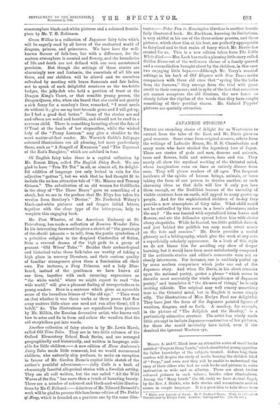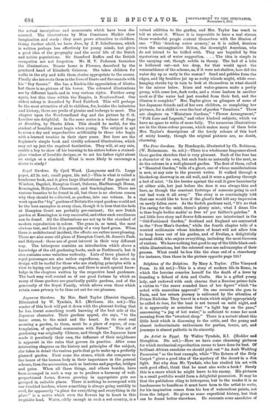Messrs. A. and C. Black issue an attractive series of
small books entitled "Peeps at Many Lands," which should whet young appetites for fuller knowledge of the subjects treated. Before long their readers will despise the study of works bearing the childish label of "Peeps," and even now they will be unable to understand the envy of their elders who had no such books and pictures to make instruction so wide and so alluring. There are about twelve coloured pictures in each volume, besides other illustrations. Among the "Many Lands" (Is. ad. each) we have Ancient Egypt, by the Bev. J. Blaikie, who tells stories and reconstructs ancient scenes in simple language. It is a good idea to take these from ths and Legends of Jovan. By F. Thalami Davis.
With 32 full-colour [7s. (id. net. J
the actual inscriptions and monuments which have been dis- covered. The illustrations by Miss Constance Blaikie show imagination and study : they must prove attractive to children. Going further afield, we have Java, by J. F. Schelterman, which is written perhaps less effectively for young minds, but gives a good idea of the geography and the social life of the Dutch and native populations. Sir Stamford Raffles and the British occupation are not forgotten. Mr. H. V. Pedersen furnishes the illustrations. Nearer home is Florence, described by the practised hand of Elizabeth Grierson. She takes children for walks in the city and tells them stories appropriate to the scenes. Finally she interests them in the lives of Dante and Savonarola with his " Boy Scouts." She has a Ruskin-like appreciation of Giotto, but there is no picture of his tower. The coloured illustrations are by different hands and in very various styles. Further away again, but this time within the Empire, is Newfoundland. Our oldest colony is described by Ford Fairford. This will perhaps be the most attractive of all to children, for, besides the industries and history, there are perils of pirates and icebergs to meet. The chapter upon the Newfoundland dog and the picture by C. G. Lowther are delightful. In the same series is a volume of Peeps at Heraldry, by Phoebe Allen. This should be useful, for the student of heraldry must begin when young. The subject is apt to seem a dry and unproductive artificiality to those who begin with a learned treatise in their riper years. But here are the beginner's simple book and vividly coloured illustrations, which may set up just the required fascination. They will, at any rate, enable a boy to show off his learning to his sisters before a stained- glass window of heraldic designs, or to set his father right about an ensign or a standard. What is more likely to encourage a desire to study?



























































 Previous page
Previous page